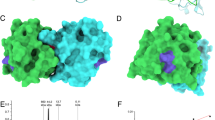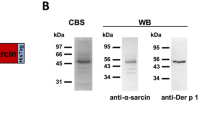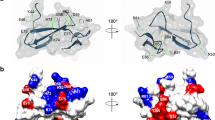Abstract
A major problem with allergen-specific immunotherapy involving repeated injections of allergens is the risk of an anaphylactic reaction. We engineered the major house dust mite allergen, Der f 2, to reduce its capacity to induce skin test reactivity and histamine release from peripheral blood basophils in allergic patients. The engineered allergen, in which the disulfide bond that linked the N- and C-terminal sequences of Der f 2 was disrupted, retained T-cell epitopes essential for immunotherapy and ability to stimulate T-cell proliferation. Such engineered allergens are potentially useful for safer and more effective immunotherapy for allergies.
This is a preview of subscription content, access via your institution
Access options
Subscribe to this journal
Receive 12 print issues and online access
$209.00 per year
only $17.42 per issue
Buy this article
- Purchase on Springer Link
- Instant access to full article PDF
Prices may be subject to local taxes which are calculated during checkout
Similar content being viewed by others
References
Moffatt, M.F., Hill, M.R., Cornélls, F., Schou, C., Faux, J.A., Young, R.P., et al. 1994. Genetic linkage of T-cell receptor alfa/delta complex to specific IgE responses. Lancet 343: 1597–1600.
Marsh, D.G., Neely, J.D., Breazeale, D.R., Ghosh, B., Freidhoff, L.R., Ehrlich-Kautzky, E., et al. 1994. Linkage analysis of IL4 and other chromosome 5q31.1 markers and total serum immunoglobulin E concentrations. Science 264: 1152–1156.
Noon, L. 1911. Prophylactic inoculation against hay fever. Lancet i: 1572–1573.
Hoyne, G.F., Kristensen, N.M., Yssel, H., and Lamb, J.R. 1995. Peptide modulation of allergen-specific immune responce. Curr. Opin. Immunol. 7: 757–761.
Norman, P.S., Ohman, J.L. Jr., Long, A.A., Creticos, P.S., Gefter, M.A., Shaked, Z., et al. 1996. Treatment of cat allergy with T-cell reactive peptides. Am. J. Respir. Crit. Care. Med. 154: 1623–1628.
van Neerven, R.J.J., Ebner, C., Yssel, H., Kapsenberg, M.L., and Lamb, J.R. 1996. T-cell responses to allergens: epitope-specificity and clinical relevance. Immunol. Today 17: 526–532.
van't Hof, W., Dridijk, P.C., van den Berg, M., Beck-Sickinger, A.G., Jung, G., and Aalberse, R.C. 1991. Epitope mapping of the Dermatophagoides pteronyssinus house dust mite major allergen Der p II using overlapping synthetic peptides. Mol. Immunol. 28: 1225–1232.
Ishizaka, T. and Ishizaka, K. 1984. Activation of mast cells for mediator release through IgE. Prog. Allergy 34: 188–235.
Metzger, H., Alcaraz, G., Hohman, R., Kinet, J.-P., Pribluda, V., and Quarto, R. 1986. The receptor with high affinity for immunoglobulin. E. Annu. Rev. Immunol. 4: 419–470.
WHO nomenclature committee for factors of the HLA system. 1995. Nomenclature for factors of the HLA system 1995. Vox Sang. 69: 359–372.
Davis, M.M. 1990. T cell receptor gene diversity and selection. Annu. Rev. Biochem. 59: 475–496.
O'Brien, R.M., Thomas, W.R., Nicholson, I., Lamb, J.R., and Tait, B.D. 1995. An immunogenic analysis of the T-cell recognition of the major house dust mite allergen Der p 2: Identification of high and low-responder HLA-DQ alleles and localization of T-cell epitopes. Immunology 86: 176–182.
Yssel, H., Johonson, K.E., Schneider, P.V., Wideman, J., Terr, A., Kastelein, R., and de Vries, J.E. 1992. T cell activation-inducing epitopes of the house dust mite allergen Der p I. Proliferation and lymphokine production patterns by Der p l-Specific CD4+T cell clones. J. Immunol. 148: 738–745.
Platts-Mills, T.A.E. and Weck, A.L. 1989. Dust mite allergens and asthma—A worldwide problem. J. Allergy Clin. Immunol. 83: 416–427.
Voohorst, R., Spieksma-Boezeman, M.I.A., Spieksma, F.T.M., Varekamp, H., Leupen, M.J., and Lyklema, A.W. 1967. The house dust mite (Dermatophagoides pteronyssinus) and the allergens it produces. Identity with the house dust allergen. J. Allergy 39: 325–339.
Miyamoto, T., Oshima, S., Ishizaki, T., and Sano, S. 1968. Allergic identity between the common floor mite (Dermatophagoides farinae Hughes 1961) and house dust as a causative agent in bronchial asthma. J. Allergy 42: 14–28.
Platts-Mills, T.A.E. and Chapman, M.D. 1987. Dust mites: Immunology, allergic disease, and environmental control. J. Allergy Clin. Immunol. 80: 755–775.
Haida, M., Okudaira, H., Ogita, T., Ito, K., Miyamoto, T., Nakajima, T., and Hongo, I. 1985. Allergens of the house dust mite Dermatophagoides farinae-Immunochemical studies of four allergic fractions. J. Allergy Clin. Immunol. 75: 686–692.
Yamashita, N., Haida, M., Suko, M., Okudaira, H., and Miyamoto, T. 1989. Allergens of house dust mite Dermatophagoides farinae. II. Immunological characterization of four allergic molecules. Int. Arch. Allergy Appl. Immunol. 88: 173–175.
Lombardero, M., Heymann, P.W., Platts-Mills, T.A.E., Fox, J.W., and Chapman, M.D. 1990. Conformational stability of B cell epitopes on group I and group II Dermatophagoides spp. allergens. Effect of thermal and chemical denaturation on the binding of mouse IgG and human IgE antibodies. J. Immunol. 144: 1353–1360.
Nishiyama, C., Fukada, M., Usui, Y., Iwamoto, N., Yuuki, T., Okumura, Y., and Okudaira, H. 1995. Analysis of the IgE-epitope of Der f 2, a major mite allergen, by in vitro mutagenesis. Mol. Immunol. 32: 1021–1029.
Smith, A.M. and Chapman, M.D. 1996. Reduction in IgE binding to allergen variants generated by site-directed mutagenesis: contribution of disulfide bonds to the antigenic structure of the major house dust mite allergen Der p 2. Mol. Immunol. 33: 399–405.
Takai, T., Yuuki, T., Okumura, Y., Mori, A., and Okudaira, H. 1997. Determination of the N- and C-terminal sequences required to bind human IgE of the major house dust mite allergen Der f 2 and epitope mapping for monoclonal antibodies. Mol. Immunol. In press.
van Neerven, R.J.J., van't Hof, W., Ringrose, J.H., Jansen, H.M., Aalberse, R.C., Wierenga, E.A., and Kapsenberg, M.L. 1993. T cell epitopes of house dust mite allergen Der p II. J. Immunol. 151: 2326–2335.
O'Hehier, R.E., Verhoef, A., Panagiotopoulou, E., Keswani, S., Hayball, J.D., Thomas, W.R., and Lamb, J.R. 1993. Analysis of human T cell responses to the group II allergen of Dermatophagoides species: localization of major antigenic sites. J. Allergy Clin. Immunol. 92: 105–113.
Tsitoura, D.C., Verhoef, A., Gelder, C.M., O'Hehir, R.E., and Lamb, J.R. 1996. Altered T cell ligands derived from a major house dust mite allergen enhance IFN-γ but not IL-4 production by human CD4+ T cells. J. Immunol. 157: 2160–2165.
Valenta, R. and Kraft, D. 1995. Recombinant allergens for diagnosis and therapy of allergic diseases. Curr. Opin. Immunol. 7: 751–756.
Yuuki, T., Okumura, Y., Ando, T., Yamakawa, H., Suko, M., Haida, M., and Okudaira, H. 1990. Cloning and sequencing of cDNAs corresponding to mite major allergen Der f II. Jpn. J. Allergol. 39: 557–561.
Yuuki, T., Okumura, Y., Ando, T., Yamakawa, H., Suko, M., Haida, M., and Okudaira, H. 1991. Cloning and expression of cDNA coding for the major house dust mite allergen Der f II in Escherichia coli. Agric. Biol. Chem. 55: 1233–1238.
Nishiyama, C., Yuuki, T., Takai, T., Okumura, Y., and Okudaira, H. 1993. Determination of three disulfide bonds in a major house dust mite allergen, Der f II. Int. Arch. Allergy Immunol. 101: 159–166.
Secrist, H., DeKruyff, R.H., and Umets, D.T. 1995. Interleukin 4 production by CD4+ T cells from allergic individuals is modulated by antigen concentration and antigen-presenting cell type. J. Exp. Med. 181: 1081–1089.
Suko, M., Mori, A., Ito, K., and Okudaira, H. 1995. Oral immunotherapy may induce T cell anergy. Int. Arch. Allergy Immunol. 107: 278–281.
O'Brien, R.M., Byron, K.A., Varigos, G.A., and Thomas, W.R. 1997. House dust mite immunotherapy results in decrease in Der p 2-specific IFN-γ and IL-4 expression by circulating T lymphocytes. Clin. Exp. Allergy 27: 46–51.
Akagawa, M., Mori, T., Ando, T., and Okudaira, H. 1992. Specific measurement of a major mite allergen, by an enzyme-linked immunosorbent assay system using monoclonal anti-Der f II antibodies. Biosci. Biotech. Biochem. 56: 1725–1727.
Dredog, S. 1985. Skin prick test. Allergy 40: 55–59.
Norman, P.S. 1993. Modern concepts of immunotherapy. Curr. Opin. Immunol. 5: 968–973.
Parronchi, P., Macchia, D., Piccinni, M.-P., Biswas, P., Simonelli, C., Maggi, E., et al. 1991. Allergen- and bacterial antigen-specific T-cell clones established from atopic donors show a different profile of cytokine production. Proc. Natl. Acad. Sci. USA 88: 4538–4542.
Nishiyama, C., Yuuki, T., Usui, Y., Iwamoto, N., Okumura, Y., and Okudaira, H. 1994. Effects of amino acid variations in recombinant Der f II on its human IgE and mouse IgG recognition. Int. Arch. Allergy Immunol. 105: 62–69.
Pruzansky, J.J., Grammer, L.C., Patterson, R., and Roberts, M. 1983. Dissociation of IgE from receptors on human basophils: I. Enhanced passive immunization for histamine release. J. Immunol. 131: 1949–1953.
Mori, A., Suko, M., Kaminuma, O., Inoue, S., Ohmura, Y., Nishizaki, Y., et al. 1996. IL-15 promotes cytokine production of human helper T cells. J. Immunol. 156: 2400–2405.
Mori, A., Kaminuma, O., Suko, M., Inoue, S., Ohmura, T., Hoshino, A., et al. 1997. Two distinct pathways of interleukin-5 synthesis in allergen-specific human T-cell clones are suppressed by glucocorticoids. Blood. In press.
Author information
Authors and Affiliations
Corresponding author
Rights and permissions
About this article
Cite this article
Takai, T., Yokota, T., Yasue, M. et al. Engineering of the major house dust mite allergen Der f 2 for allergen-specific immunotherapy. Nat Biotechnol 15, 754–758 (1997). https://doi.org/10.1038/nbt0897-754
Received:
Accepted:
Issue Date:
DOI: https://doi.org/10.1038/nbt0897-754
This article is cited by
-
Structural biology of mite allergens
Molecular Biology Reports (2013)
-
Engineered Alt a 13 Fragment of Alternaria alternata Abrogated IgE Binding without Affecting T-cell Stimulation
Journal of Clinical Immunology (2009)
-
The 3′-untranslated region of rice glutelin GluB-1 affects accumulation of heterologous protein in transgenic rice
Biotechnology Letters (2009)
-
Genetically engineered vaccines
Current Allergy and Asthma Reports (2005)



